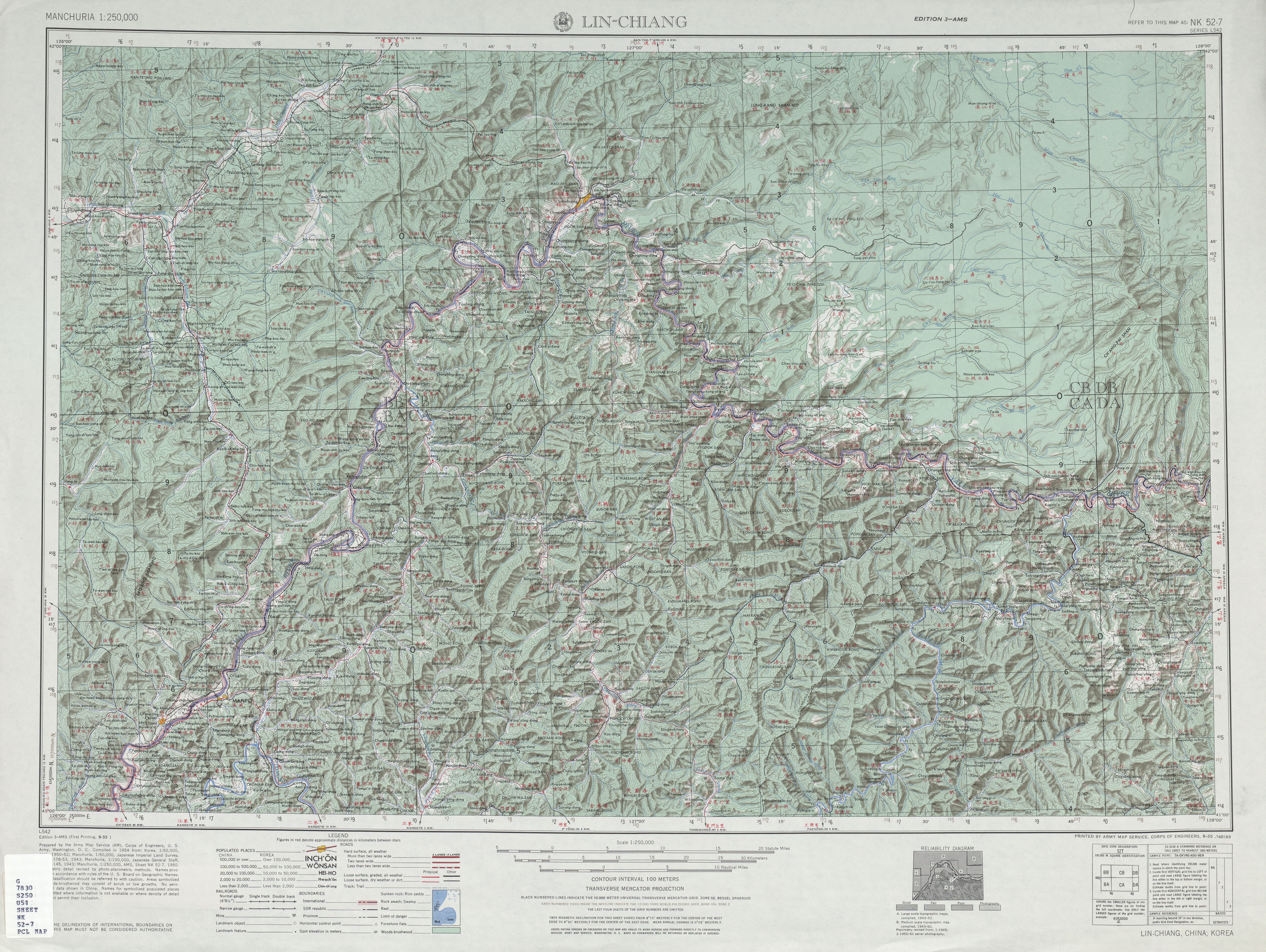|
Linjiang
Linjiang (; listed as Linkiang on old maps) is a county-level city in southern Jilin province, People's Republic of China, located to the east of Tonghua, and not far from the border with North Korea. It is a county-level city under the administration of Baishan. Culture During 1953–76, there was a total of twenty one Chinese films being shot on location in Linjiang, including ''Visitors on the Icy Mountain.'' Geography and Climate Linjiang has a monsoon-influenced humid continental climate (Köppen ''Dwa''), with long, very cold winters, and very warm, humid summers. Monthly average temperatures range from in January to in July, and the annual mean is . Though the annual total is generous, precipitation is quite low during the winter and rainfall is concentrated in the months of June through August. Sunshine is generous but falling far short of the central and western parts of Jilin; with monthly percent possible sunshine ranging from 42% in July to 60% in February, there ... [...More Info...] [...Related Items...] OR: [Wikipedia] [Google] [Baidu] |
Baishan
Baishan (, ko, 백산시) is a prefecture-level city in southeastern Jilin province, in the Dongbei (northeastern) part of China. "" literally means "White Mountain", and is named after Changbai Mountain (, also known as Paektu Mountain (Korean: )). Baishan borders Yanbian to the east, Tonghua to the southwest, Jilin City to the north, and North Korea to the south. Baishan is to be granted the title of China International Mineral Water City. In Baishan is the Baishan Dam. History In 1902, Qing imperial government set up the Linjiang County in today's Baishan region. During the Manchukuo period, Linjiang county was under the jurisdiction of Tonghua. In March 1959, Jilin provincial government promoted Linjiang County to a county-level city and renamed it as Hunjiang City, which is still under the administration of Tonghua Prefecture. In 1985, Hunjiang City developed into a prefecture-level city, administerring three districts and three counties including Fusong, Jingyu and Ch ... [...More Info...] [...Related Items...] OR: [Wikipedia] [Google] [Baidu] |
County-level City
A county-level municipality (), county-level city or county city, formerly known as prefecture-controlled city (1949–1970: ; 1970–1983: ), is a Administrative divisions of China#County level (3rd), county-level administrative division of the China, People's Republic of China. County-level cities have judiciary, judicial but no legislature, legislative rights over their own local ordinance, local law and are usually governed by Administrative divisions of China#Prefectural level (2nd), prefecture-level divisions, but a few are governed directly by Administrative divisions of China#Provincial level (1st), province-level divisions. A county-level city is a "city" () and "county" () that have been merged into one unified jurisdiction. As such it is simultaneously a city, which is a municipal entity and a county which is an administrative division of a prefecture. Most county-level cities were created in the 1980s and 1990s by replacing denser populated Counties of Chin ... [...More Info...] [...Related Items...] OR: [Wikipedia] [Google] [Baidu] |
County-level City
A county-level municipality (), county-level city or county city, formerly known as prefecture-controlled city (1949–1970: ; 1970–1983: ), is a Administrative divisions of China#County level (3rd), county-level administrative division of the China, People's Republic of China. County-level cities have judiciary, judicial but no legislature, legislative rights over their own local ordinance, local law and are usually governed by Administrative divisions of China#Prefectural level (2nd), prefecture-level divisions, but a few are governed directly by Administrative divisions of China#Provincial level (1st), province-level divisions. A county-level city is a "city" () and "county" () that have been merged into one unified jurisdiction. As such it is simultaneously a city, which is a municipal entity and a county which is an administrative division of a prefecture. Most county-level cities were created in the 1980s and 1990s by replacing denser populated Counties of Chin ... [...More Info...] [...Related Items...] OR: [Wikipedia] [Google] [Baidu] |
Xinshi Subdistrict, Linjiang
Xinshi Subdistrict () is a subdistrict of Linjiang, Jilin, People's Republic of China. , it has two residential communities () and two villages under its administration. See also *List of township-level divisions of Jilin This is a list of township-level divisions of the province of Jilin, People's Republic of China (PRC). After province, prefecture, and county-level divisions, township-level divisions constitute the formal fourth-level administrative divisions ... References Baishan Township-level divisions of Jilin {{Jilin-geo-stub ... [...More Info...] [...Related Items...] OR: [Wikipedia] [Google] [Baidu] |
Jilin
Jilin (; alternately romanized as Kirin or Chilin) is one of the three provinces of Northeast China. Its capital and largest city is Changchun. Jilin borders North Korea (Rasŏn, North Hamgyong, Ryanggang and Chagang) and Russia (Primorsky Krai) to the east, Heilongjiang to the north, Liaoning to the south, and Inner Mongolia to the west. Along with the rest of Northeast China, Jilin underwent an early period of industrialization. However, Jilin's economy, characterized by heavy industry, has been facing economic difficulties with privatization. This prompted the central government to undertake a campaign called "Revitalize the Northeast". The region contains large deposits of oil shale. Name The name "Jilin" originates from ''girin ula'' () , a Manchu phrase meaning "along the river", shortened to Kirin in English. This Manchu term was transcribed into ''jilin wula'' ( t , s ) in Chinese characters and shortened the first two characters, which are tran ... [...More Info...] [...Related Items...] OR: [Wikipedia] [Google] [Baidu] |
Xinglong Subdistrict, Linjiang
Xinglong may refer to the following locations in China: * Xinglong County (兴隆县), Chengde, Hebei * Xinglong Station (NAOC) (兴隆观测基地), an observatory situated in the Yanshan Mountains Townships (兴隆乡) * Xinglong Township, Anhui, in Jingde County * Xinglong Township, Baiyin, in Jingyuan County, Gansu * Xinglong Township, Xihe County, Gansu *Xinglong Township, Dafang County, Guizhou * Xinglong Township, Fuquan, Guizhou * Xinglong Township, Tongren, in Sinan County, Guizhou * Xinglong Township, Harbin, in Wuchang City * Xinglong Township, Wudalianchi, Heilongjiang *Xinglong Township, Gannan County, Heilongjiang * Xinglong Township, Henan, in Kaifeng County * Xinglong Township, Jiangsu, in Xuyi County *Xinglong Township, Jilin, in Fusong County *Xinglong Township, Ningxia, in Tongxin County *Xinglong Township, Shandong, in Jinxiang County *Xinglong Township, Tongjiang County, Sichuan *Xinglong Township, Xuyong County, Sichuan *Xinglong Township, Yunnan, in Yanjin ... [...More Info...] [...Related Items...] OR: [Wikipedia] [Google] [Baidu] |
Township (People's Republic Of China)
Townships (), formally township-level divisions (), are the basic level (fourth-level administrative units) of political divisions in China. They are similar to municipalities and communes in other countries and in turn may contain village committees and villages. In 1995 there were 29,502 townships and 17,532 towns (a total of 47,034 township-level divisions) in China. Much like other levels of government in mainland China, the township's governance is divided between the Communist Party Township Secretary, and the "county magistrate" (). The township party secretary, along with the township's party committee, determines policy. The magistrate is in charge of administering the daily affairs of government and executing policies as determined by the party committee. A township official is the lowest-level ranked official in the civil service hierarchy; in practice, however, the township party secretary and magistrate can amass high levels of personal power. A township government ... [...More Info...] [...Related Items...] OR: [Wikipedia] [Google] [Baidu] |
Dahu Subdistrict
The dahu is a legendary creature that resembles a mountain goat and is well known in France and francophone regions of Switzerland and Italy, including the Aosta Valley. The dahu, a quadrupedal mammal, may have been inspired by the chamois, a small, horned goat-antelope once plentiful in European mountainous regions, and also resembles the ibex. Regional variations on its name include dahut or dairi in Jura, darou in Vosges, daru in Picardy, darhut in Burgundy, daù in Val Camonica; also called a tamarou in Aubrac and Aveyron, and tamarro in Catalonia and Andorra. The dahu cub is called a dahuot. Description The dahu's principal distinguishing characteristic is that the legs on one side of its body are shorter than the legs on the opposite side, to facilitate standing on and walking on steep mountain slopes. In practical terms, the dahu's asymmetrical limbs allow it to walk around the circumference of the mountain ''in only one direction''. Therefore, there are two different ty ... [...More Info...] [...Related Items...] OR: [Wikipedia] [Google] [Baidu] |
Huashu (town)
The ''Huashu'' (), or The ''Book of Transformations'', is a 930 CE Daoist classic about ''neidan'' "internal alchemy", psychological subjectivity, and spiritual transformation. In the description of Poul Andersen, The ''Huashu'' is a unique philosophical work of the period of the Five Dynasties, which syncretizes elements of Taoist, Buddhist, and Confucian thought, and which has been noted in recent times for its scientific observations (for instance regarding optics and acoustics) and for its unusual emphasis on epistemological considerations. Its influence during the Song and subsequent dynasties was substantial, both within Taoist and Confucian metaphysics, and especially as foundation of alchemical thought. Authors Authorship of the ''Huashu'' is associated with three people. The Southern Tang (937–975 CE) chancellor Song Qiqiu 宋齊丘 first published it under his name, but evidence suggests he plagiarized the ''Huashu'' from its primary author Tan Qiao 譚峭, who later s ... [...More Info...] [...Related Items...] OR: [Wikipedia] [Google] [Baidu] |
Subdistrict (China)
A subdistrict ()' is one of the smaller administrative divisions of China, administrative divisions of China. It is a form of townships of China, township-level division which is typically part of a larger urban area, as opposed to a discrete towns of China, town (zhèn, 镇) surrounded by rural areas, or a rural townships of China, township (xiāng, 乡). In general, urban areas are divided into subdistricts and a subdistrict is sub-divided into several residential community, residential communities or neighbourhoods as well as into villagers' groups (居民区/居住区, 小区/社区, 村民小组). The subdistrict's administrative agency is the subdistrict office ()"【街道办事处】 jiēdào bànshìchù 市辖区、不设区的市的人民政府派出机关。在上一级政府领导下,负责本辖区内的社区服务、经济发展、社会治安等工作。" or simply the jiedao ban (街道办, jiēdào bàn). Because of the influence of the literal meaning of ... [...More Info...] [...Related Items...] OR: [Wikipedia] [Google] [Baidu] |


